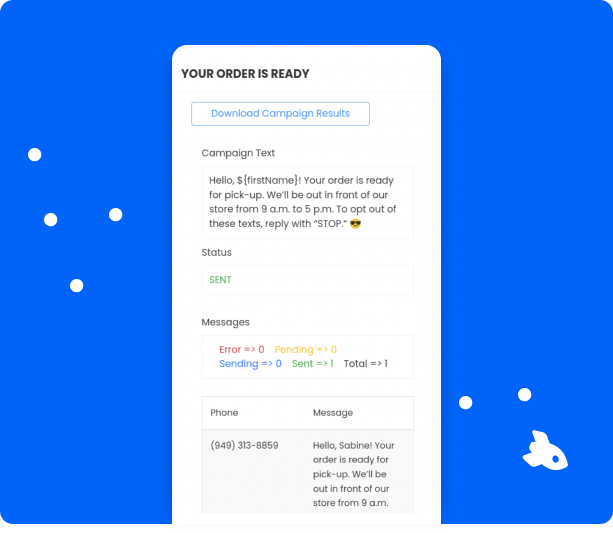Data and Analytics for SMS Marketing
As your business grows, your marketing efforts are going to play an enormous role in ensuring that your growth is happening at the rate and in the direction that you want it to. However without tangible and trackable goals, your tireless efforts to grow may be in vain. Data and analytics are the foundation upon which your goals should be set, tracked and finally: achieved.
Determining what to track and how can seem like a daunting task without proper guidance and knowledge, which is why this guide will aim to arm you with the information needed to begin maximizing your marketing efforts.
“If you aim at nothing, you will hit it every time.”
Which Statistics and Analytics To Focus On
What is a KPI?
According to the Oxford dictionary’s definition: A Key Performance Indicator (KPI) is a quantifiable measure used to evaluate the success of an an organization, employee, etc. in meeting objectives for performance.
In essence, a KPI is a trackable goal or metric which is used to evaluate something’s effectiveness.
There are sevaral commonly used metrics associated with SMS marketing for businesses. Their order of importance cann vary depending on the industry, campaign, and audience.
Types of SMS Statistics
Delivery Rate: A Delivery Rate is the percentage of your texts successfully delivered by the campaign.
Unsubscribe Rate: The percentage of your audience who has unsubscribed from receiving further text messages from the total number of subscribers in a given SMS campaign.
Response Rate: The percentage of your campaigns successfully delivered messages that were responded to by the recipients.
Response Time: The average time between when your audience receives a message and when they respond to it.
Click Through Rate (CTR): The percentage of clicks received on your messages that contain a link.
Time to Resolution: The average time between when you have received an inbound message/inquiry/problem and when that problem is resolved.
Time to Respond: The average amount of time between when you have received an inbound message and when that message has been responded to.

Track User Engagement
Detailed user engagement reporting and analytics for individuals, departments, locations, and more.
Data in Real-Time
Stay informed with accurate data reporting and alaytics in real time.
Delivery Report Notifications
Receive notifications for successful deliveries, errors, and more. Fully customizable to meet your specific needs.
Which Analytics to Focus On for Different Uses
Customer Service and Customer Support
Customer service or customer support analytics revolve around increasing satisfaction while taking care of customers in the shortest time possible.
Consideration of your customer’s time is crucial to a quality customer service model. This is why it’s no surprise that two important issues with customer service metrics have to do with timeliness. Time to resolution is the first metric for tracking and establishing goals with the customer service or support industry. How long are your customers waiting for their problems to be resolved? If you don’t know, it’s time to start keeping track and slowly moving the needle to faster resolutions without compromising the quality of your service.
Time to Respond is the second metric to focus on in customer service and customer support. When your company receives inbound inquiries or responses to your outbound campaigns, making your customers wait is the last thing you should do. Appreciating your customers’ time is something that they will notice immediately, and if it is ignored, it could result in the loss of a customer.
Sales and Marketing
The first and foremost metric to keep track of is your delivery rate. To get your message across to your audience, you must ensure that your campaigns are being received and delivered properly before beginning to plan future campaigns or analyze your other metrics. The greatest marketing campaign in the world won’t matter if it isn’t effectively reaching your audience.
One of the important statistics to keep an eye on is your business’s unsubscribe rate. If you notice high unsubscribe rates, this should be a red flag to your current marketing strategy. Your audience may find your campaigns less useful than they originally hoped, and even worse, they may begin to report your campaigns as spam. For a more comprehensive look at examples of spam text messages, look at our full coverage blog here.
Another data point to begin tracking for your sales and marketing efforts is your response rate. Your response rate is a quality indication of the effectiveness of your campaigns as well as an insight to your overall engagement with your customers. Higher response rates indicate a well received message, and shows your audience cares enough to take the time to initiate a 2 way communication channel.
SMS Statistics VS Email Statistics
Data and analytics for email campaigns share many common themes. Nealy all of the important metrics for SMS campaigns, directly correlate to email campaigns and data tracking. For more information on how to check your email campaign scores, check out our comprehensive article here.
Comparative Analytics for Strategic Decision Making
To further enhance operational efficiencies, it’s crucial to delve deeper into specific metrics like response time and the number of conversations needed to resolve. Tracking how quickly team members respond to messages can significantly impact the time it takes to resolve issues. Faster responses improve customer satisfaction and streamline internal workflows, reducing downtime and increasing productivity.
- Cross-Platform Analysis: Comparing SMS analytics with phone and email metrics allows operations teams to identify the most effective communication channels. This comparative analysis helps make informed decisions about resource allocation and channel optimization.
- Resolution Efficiency: By monitoring the number of conversations required to resolve a query, teams can assess the efficiency of their communication strategies. This metric is particularly useful for pinpointing areas that may benefit from additional training or automated responses.
Closing Thoughts
In order to improve your businesses marketing efforts and growth, tracking your progress towards quantifiable goals is key. Tracking data and analytics will allow your business to flourish, and will ensure your SMS marketing efforts yield the results you’re looking for.
Not sure if you’re ready to revolutionize the way your business communicates? Sign up for our 14-day free trial!
What do you have to lose?




